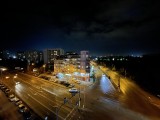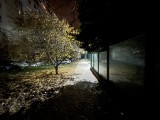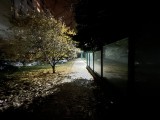Apple iPhone 12 mini review

A dual-camera for the iPhone 12 mini, too
The Apple iPhone 12 mini has the same cameras you'd find on the regular iPhone 12. There are two 12MP snappers on the back and one 12MP selfie at the front. The SL 3D scanner for Face ID assists the Portrait mode in selfies, too.

The primary camera uses a 12MP sensor with 1.4µm large pixels and a 26mm wide lens. The aperture is brighter at f/1.6 vs. f/1.8 on the iPhone 11 series. Optical image stabilization is available, as well as dual pixel autofocus.
The second camera is another 12MP imager with smaller 1.0µm pixels and 13mm f/2.4 lens for ultrawide photos. The focus is fixed, and there is no OIS.
The selfie camera uses a 12MP sensor with 1.0µm pixels and a 23mm f/2.2 lens. The focus is once again fixed. When using portrait mode on this camera, it captures depth info with the structured-light 3D scanner, so should be taking some impressive selfies portraits.

All three snappers support up to 4K@60fps video capturing with Cinematic Stabilization (EIS, EIS+OIS) and Expanded Dynamic Range. Dolby Vision HDR capturing is possible on all cameras in all 30fps modes.
Camera app and features
The viewfinder is mostly unchanged since iOS 13 and iPhone 11 - you can see outside of the viewfinder thanks to the precise calibration of the two cameras that allows seeing what will be left outside the frame in real-time. This really makes for a more immersive camera experience, and if Photo/Video Capture Outside the Frame is enabled, then you can later expand your footage from the Photos app if something important was cut.
The new Apple image processing that's possible thanks to the new A14 chip includes Smart HDR 3, Night Mode on all cameras, and Deep Fusion.

The Smart HDR 3 name speaks for itself - it's improved HDR processing used in challenging conditions and scenes.
The Night Mode icon pops up automatically when a low-light occasion presents itself, and it will take a pseudo-long-exposure shot, handheld, of course. You will see the seconds suggested next to the Night Mode icon, but you can change the simulated long exposure or altogether disable it if you tap on it. Usually, it's between 1 and 2 seconds, but sometimes the phone allows you to go for up to 30 seconds depending on the environmental light or its lack. You can use this mode on the main, the ultrawide, and even the selfie snapper.
Deep Fusion is used when light conditions aren't ideal, say, indoors. It triggers instead of Smart HDR and Night Mode. Deep Fusion uses four frames before you hit the shutter, four more once you do, and one long exposure shot. The 16-core Neural engine will select the best frames and create a high-quality HDR photo that is very detailed, sharp, and more natural-looking. The Neural processor's machine learning process analyzes the image being taken and processes them differently depending on what's in the frame - say, sky, foliage, or skin tones. Meanwhile, structure and color tones are based on ratios obtained by the Neural unit on the A14 CPU.
As usual, all cameras talk to each other, so they already know the correct exposure and tone mapping settings when you switch between them. This applies for both stills and videos.
The camera interface is mostly unchanged. You swipe between modes and have a couple of settings you can uncover with an upward swipe - flash, night mode, live photo, photo aspect, exposure compensation, and filters. In video mode, you can change the resolution and frame rate from the viewfinder.
Portrait mode is available on the main and the selfie cameras. There is no RAW mode on the iPhone 12 mini.
Photo quality
The primary camera shoots good-looking photos though imperfections begin to pile up under scrutiny. Looking at 100% zoom, you will see that intricate details such as grass and other foliage are rendered rather mediocre. Complect objects like bushes, blinds, people, car plates, etc. present a challenge for the camera, and their sub-par rendition is often masked with over-sharpening.
On a positive note - all photos show well-handled noise, accurate white balance, and colors, as well as high contrast. The sharpness seems balanced outside of the tricky areas we mentioned.
The dynamic range is well above the average - it seems the Smart HDR aims to achieve a balanced and realistic look without going over the board with the dynamic range, and we are liked what we saw.
The iPhone 12 mini has the same ultrawide camera as the rest of the Series 12, and it's very wide, alright. The mini supports automatic distortion correction is it is done with excellent proficiency.
The 12MP ultrawide photos from the iPhone 12 mini have average detail, and foliage is an even tougher challenge here. Still, these photos show reasonably low noise, good contrast, and accurate white balance. The snappers are calibrated well, and the colors are once again true to reality.
All cameras on the iPhone 12 mini support Night Mode, which automatically gets triggered in low-light scenes. You can opt-out of it using it or correct the suggested exposure time, but we strongly recommend leaving it on automatic. It usually uses 1s or 2s exposures, the image is saved instantly, and it's won't turn the night into day.
The images shot with the Auto Night Mode are excellent - they are with well-balanced exposure and preserved highlights. The photos are sharp and detailed, with low noise levels and yet gentle noise reduction. The color saturation is kept natural without going overboard, and the contrast is great.
If you turn off the Night Mode where it was suggested, you'd get a photo with lower sharpness and contrast. Noise is a bit more too, and the colors are not that well saturated. You'd still get a good shot, but why not a great one, right?












Main camera Night Mode OFF, 12MP
The ultrawide camera supports Night Mode as promised, and it always triggers at night. The resulting ultrawide photos are pretty usable with balanced exposure and restored highlights. There are enough details and true-to-life color saturation. Sure, these are noisy and soft, yes, but usable, nevertheless.
Finally, you can check these ultrawide shots taken without Night Mode. These are not pretty - the detail is low, and the images are very soft, then the noise is too high, and the colors are sometimes completely desaturated.












Ultrawide camera Night Mode OFF, 12MP
You can also look at our photo compare tool and see how the Apple iPhone 12 mini stands against some of its rivals.



Apple iPhone 12 mini vs. Apple iPhone SE (2020) and the Samsung Galaxy S20 in our Photo compare tool
Shootout with iPhone 12
We imagine many people will be choosing between the iPhone 12 mini and the iPhone 12. Apple has promised consistent camera performance, but doubt is part of our human nature. And so we did a small shootout between these two phones, and the photos are in.
First, we shot some scenes with the main snappers. These are virtually identical - with all the pros and cons we observed through our reviews.
Same applies for the ultrawide shooters - those snap identical images under the same conditions.




iPhone 12 mini ultrawide cam, 12MP
The photos we took at night-time with automatic settings are also identical across the board, not that we expected anything else. Both phones snap balanced and realistic night shots.
Finally, the ultrawide photos shot with automatic settings are good on both phones, while their quality is once again the same.






iPhone 12 mini ultrawide cam, 12MP
Obviously, if everything boils down to the choice between the iPhone 12 and the 12 mini - their camera should be of no concern to you. Only their size and battery life will matter in this case.
Portrait mode
Portraits are available on the iPhone 12 mini, and those are shot with the main camera. And the portraits we took with the mini are brilliant. They are sharp and rich in detail, with true to life colors, superb contrast, and very natural looking blur. The subject separation is quite competent and will rarely clip an ear or hair and clothes.
We've already established in our previous iPhone 12 reviews that you can, in fact, get good portrait photos in low-light scenes even without the presence of a LiDAR scanner. Here, check these out.
These images are a bit darker than expected though the Deep Fusion puts up a good fight, a bit desaturated, too, but still very much usable. They can get better, though!
Just put these default portraits through Photo's Auto Enhance feature, and you'd end up bright and saturated portrait photos, similar to what you'd get with the iPhone 12 Pro.
Selfies
Apple offers two Field-of-View modes on the selfie camera - the slightly zoomed-in 7MP crop that is equivalent to a 30mm field of view and the full 12MP mode, which has a 23mm equivalent FoV.
If you hold the phone in portrait orientation, selfies are cropped to 7MP to provide a tighter framing but rotate the phone horizontally, and you get more of the scene with the phone automatically switching to the wider 12MP mode. You can also switch between those two modes manually.
The 12MP selfies are class-leading - high in detail and contrast, with great colors and well-handled noise. The HDR isn't as aggressive on many of the Android phones and provides for a natural and balanced look.
Portrait mode is present on the front camera, and it is assisted by the SL 3D snapper. Quite expectedly, the subject separation is outstanding with impressive background blur. These are shot in 7MP, meaning the camera crops a part of its available FoV and shows a zoomed-in shot.
Night Mode is available on the selfie camera, too, and it does brighten the whole photo and exposes more detail. The images are still soft and noisy, yet rather usable.




Auto • Night Mode OFF • Auto • Night Mode OFF
Video recording
The iPhone 12 mini captures video at various resolutions and framerates with all three cameras, and it can even do it simultaneously if you have the right app.
All videos are digitally (also optically where available) stabilized thanks to the cinematic video stabilization. All modes, including the 4K@60fps, feature an expanded dynamic range thanks to the Smart HDR. The slow-mo options max out at 1080p at 240fps.
The iPhone 12 series is the first to allow video capture straight into the Dolby Vision dynamic HDR video format. You can edit these videos on-the-go on your phone, you can upload them on YouTube or any other popular platform, or even send them to your friends. The Dolby Vision information is saved outside of the video stream, so the video will look normal to any non-HDR player/screen and will be color-boosted on any Dolby Vision-compatible player and display. HDR video capturing is available in all resolutions at 30fps.
Note that if you want to transfer Dolby Vision video file to PC or Mac, your iPhone transfer options should be set to Keep Originals. Otherwise (Most Compatible), you will get a converted non-HDR video for better compatibility.
If your display isn't Dolby Vision-capable - Dolby Vision original files will still play. They would still appear with low dynamic range and duller colors compared to non-HDR or converted (Most Compatible) files.
The iPhone 12 mini captures wide stereo audio for the videos at 192kbps. This means spatial sound, just like some HTCs and some old Nokia phones did, as well as the iPhone 11 Pro duo, and you should enjoy richer and deeper sound if compared to just regular stereo.
The 4K videos captured both at 60 and 30 fps with the main camera are quite vibrant and show excellent contrast, low noise, impressive dynamic range, while colors stay true to life.
Rendering fine detail isn't great, but unlike photos, you don't normally zoom in videos to inspect details, so you are unlikely to notice it.
The 4K footage from the ultrawide snapper is also identical in both 30fps or 60fps options. The resolved detail, however, is mediocre, and the corners are plenty soft though not warped. The dynamic range, colors, and contrast are superb, as usual.
The low-light 4K videos look good - they are detailed enough, with good colors and reasonably low noise.
Cinematic stabilization is available on all cameras, resolutions, and fps options. It works peachy, as it always has on the iPhones.
The iPhone 12 phones can all do Night-Mode Time-lapse. You just select Time-lapse, mount your iPhone on a tripod, and hit the shutter. The camera app offers no settings whatsoever, and the videos are saved in 1080p@30fps format. We shot such a time-lapse for 25 minutes (compressed in 25 seconds), and it is indeed stunning. Everything looks great, and we can only imagine such a video shot in the right place and at the right time.
And here is a selfies 4K sample from the front camera. The clip is very good in detail and excels in everything else.
All videos we've posted here are non-HDR. We tried shooting them in HDR, and they look exactly the same to any non-HDR player and monitor. When we watched these HDR videos on the iPhone's screen, we did notice somewhat richer colors and expanded dynamic range - but that's hard to show online. If you do have a Dolby Vision-capable TV or monitor and opt for an iPhone 12, then you could enjoy the said boost in colors and dynamic range as well.
You can also look at our video compare tool and see how the iPhone 12 mini stands against some of its rivals.



4K: Apple iPhone 12 mini vs. Apple iPhone SE (2020) and the Samsung Galaxy S20 in our Video compare tool
Reader comments
- Hehe
- 07 Aug 2024
- p$x
S23 to i12 mini is a big downgrade, like - are you even serious?
- Anonymous
- 19 Mar 2024
- sgj
Still relevant about battery life ? I have an s23 with a stunning battery life, but I saw some nice iPhone 12 mini renewed. Like, hanging out a few hours, 30 minutes maps, some text, 10 minutes web, commuting. I wonder if the little batter...
- Anonymous
- 17 Aug 2023
- vaS
Have you tried using a browser with adblocker? Modern web is a mess if you don't have any adblock on any device.



































































































